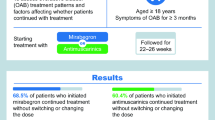Abstract
The embarrassment and social stigma associated with urinary incontinence (UI) in overactive bladder syndrome (OAB) sufferers is a major reason for individuals to seek help for their condition. An analysis of 1,873 subjects with OAB with UI was conducted to assess the efficacy of solifenacin in reducing incontinence in a pooled population from four phase III clinical trials, stratified by severity of incontinence, urgency, and other key factors at baseline. Subjects were randomized to either 5 or 10 mg of solifenacin once daily or placebo for 12 weeks. More than 50% of the total population became continent at study end, with either dose of solifenacin (P<0.01 vs placebo). Significant reductions in incontinence episodes and higher rates of attainment of continence vs placebo were observed irrespective of age or severity of incontinence or urgency at baseline with solifenacin treatment. Treatment was well tolerated, with the majority of adverse events being mild in nature. Solifenacin is an effective antimuscarinic agent for the treatment of incontinence associated with OAB.

Similar content being viewed by others
References
Abrams P, Cardozo L, Fall M, Griffiths D, Rosier P, Ulmsten U et al (2003) The standardisation of terminology in lower urinary tract function: report from the standardisation sub-committee of the International Continence Society. Urology 61(1):37–49
Milsom I, Abrams P, Cardozo L, Roberts RG, Thuroff J, Wein AJ (2001) How widespread are the symptoms of an overactive bladder and how are they managed? A population-based prevalence study. BJU Int 87(9):760–766
Milsom I, Stewart W, Thuroff J (2001) The prevalence of overactive bladder. Am J Manag Care 6(11):S565–S573
Hu TW, Wagner TH, Bentkover JD, Leblanc K, Zhou SZ, Hunt T (2004) Costs of urinary incontinence and overactive bladder in the United States: a comparative study. Urology 63(3):461–465
Diokno AC, Appell RA, Sand PK, Dmochowski RR, Gburek BM, Klimberg IW et al (2003) Prospective, randomized, double-blind study of the efficacy and tolerability of the extended-release formulations of oxybutynin and tolterodine for overactive bladder: results of the OPERA trial. Mayo Clin Proc 78(6):687–695
Cardozo L (2004) Randomized, double-blind placebo-controlled trial of once-daily antimuscarinic agent solifenacin succinate in patients with overactive bladder. J Urol 172:1919–1924
Chapple CR, Rechberger T, Al-Shukri S, Meffan P, Everaert K, Huang M et al (2004) Randomized, double-blind placebo- and tolterodine-controlled trial of the once-daily antimuscarinic agent solifenacin in patients with symptomatic overactive bladder. BJU Int 93(3):303–310
Gittelman M (2003) The efficacy and safety of solifenacin in adults with overactive bladder: a multicenter, placebo-controlled study (abstract TP76). Int J Gynecol Obstet 83(Suppl 3):94
Gittelman M, Kaufman J (2003) Solifenacin succinate 10 mg once daily significantly improves symptoms of overactive bladder. Presented at the 17th International Federation of Gynecology and Obstetrics World Congress, Santiago, Chile, 2–7 November 2003
Ouslander JG (2002) Geriatric considerations in the diagnosis and management of overactive bladder. Urology 60(5 Suppl 1):50–55
Stewart WF, Van Rooyen JB, Cundiff GW, Abrams P, Herzog AR, Corey R et al (2003) Prevalence and burden of overactive bladder in the United States. World J Urol 20(6):327–336
Kobelt G (1997) Economic considerations and outcome measurement in urge incontinence. Urology 50(6A Suppl):100–107
Coyne KS, Zhou Z, Thompson C, Versi E (2003) The impact on health-related quality of life of stress, urge and mixed urinary incontinence. BJU Int 92(7):731–735
Coyne KS, Payne C, Bhattacharyya SK, Revicki DA, Thompson C, Corey R et al (2004) The impact of urinary urgency and frequency on health-related quality of life in overactive bladder: results from a national community survey. Value Health 7(4):455–463
Acknowledgement
This study was undertaken with a research grant from Yamanouchi Pharmaceutical Co., Ltd., Tokyo, Japan.
Author information
Authors and Affiliations
Corresponding author
Rights and permissions
About this article
Cite this article
Cardozo, L., Castro-Diaz, D., Gittelman, M. et al. Reductions in overactive bladder-related incontinence from pooled analysis of phase III trials evaluating treatment with solifenacin. Int Urogynecol J 17, 512–519 (2006). https://doi.org/10.1007/s00192-005-0058-6
Received:
Accepted:
Published:
Issue Date:
DOI: https://doi.org/10.1007/s00192-005-0058-6




